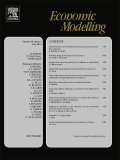
ECONOMIC MODELLING
Scope & Guideline
Elevating Economic Analysis to New Heights.
Introduction
Aims and Scopes
- Macroeconomic Analysis:
The journal focuses on macroeconomic modeling, including the study of business cycles, inflation, and the impact of fiscal and monetary policies on economic stability. - Microeconomic Foundations:
Research often delves into microeconomic factors such as firm behavior, consumer choice, and market structures, using advanced econometric methods to derive insights from empirical data. - Environmental Economics:
There is a significant emphasis on environmental policies and their economic implications, particularly in the context of climate change, carbon pricing, and sustainable practices. - Financial Economics:
The journal covers topics related to financial markets, including asset pricing, risk management, and the effects of regulatory changes on financial stability. - Trade and Development:
Research related to international trade dynamics, development economics, and the impacts of globalization on local economies is a core focus area. - Behavioral Economics and Decision-Making:
The journal includes studies that explore behavioral aspects of economic decision-making, examining how psychological factors influence market outcomes. - Quantitative Methods and Modeling Techniques:
A distinctive feature of the journal is its commitment to using advanced quantitative methods and models, including DSGE models, agent-based simulations, and machine learning techniques.
Trending and Emerging
- Digital Economy and Transformation:
Research exploring the implications of digitalization on economic performance, business models, and consumer behavior is rapidly gaining traction, especially post-COVID-19. - Sustainable Development and Green Economics:
There is a rising focus on sustainable economic practices, including green finance, corporate social responsibility, and the economic impacts of environmental regulations. - Health Economics and Policy:
In light of recent global health crises, studies examining the economic impacts of health policies, healthcare access, and the interplay between health outcomes and economic performance have become increasingly important. - Behavioral Insights in Economic Decision-Making:
Emerging research incorporates behavioral economics to understand how cognitive biases and social factors influence economic decisions, particularly in financial markets. - Impact of Global Events on Economic Dynamics:
The journal is seeing more studies analyzing the economic impacts of global events, such as pandemics, geopolitical tensions, and climate change, emphasizing the interconnectedness of economies. - Machine Learning and Big Data in Economic Analysis:
The integration of machine learning techniques and big data analytics into economic modeling and forecasting is a significant trend, reflecting advancements in technology and data availability.
Declining or Waning
- Traditional Labor Economics:
Research specifically focused on traditional labor economics, such as wage dynamics and employment rates, has become less prevalent, possibly overshadowed by the more impactful themes of labor market disruptions due to technology and globalization. - Single-Factor Economic Models:
There has been a waning interest in simplistic single-factor models that do not capture the complexity of economic interactions, with researchers preferring more integrated approaches. - Static Econometric Models:
The use of static econometric models is declining in favor of dynamic models that account for time-varying relationships and structural changes in economic data. - Region-Specific Studies:
Research focusing on specific regions without broader implications or comparisons has decreased, as there is a growing preference for studies with global relevance or comparative analyses. - General Equilibrium Models with Simplistic Assumptions:
There is a noticeable decline in the application of general equilibrium models based on overly simplistic assumptions, as researchers increasingly recognize the need for more nuanced frameworks.
Similar Journals

Eurasian Economic Review
Innovative research for a changing economic landscape.Eurasian Economic Review is a premier academic journal dedicated to the dissemination of high-quality research in the field of economics, notably within the Eurasian context. Published by SPRINGER HEIDELBERG in Switzerland, this journal stands out with an impressive Q2 ranking in the 2023 category of Economics, Econometrics and Finance, reflecting its influential role in fostering scholarly dialogue. The journal encompasses a broad array of topics related to economic trends, policy impacts, and theoretical advancements, making it an essential resource for researchers, professionals, and students alike. With a consistent output since its inception in 2011, the Eurasian Economic Review is committed to providing open access to its valuable content, ensuring that important findings are widely available to the global research community. As a member of the top 9th percentile in Scopus rankings for its field, this journal uniquely positions itself as a vital conduit for innovative and impactful research in economics.

Annals of Economics and Finance
Advancing Knowledge in Economics and Financial Theory.Annals of Economics and Finance is an esteemed academic journal published by Wuhan University Journals Press, focusing on the fields of Economics and Finance. Established in 2000, this journal serves as a platform for scholars to disseminate their research findings and insights, contributing to the development of these disciplines through rigorous peer-reviewed articles. Despite currently holding a Q4 ranking in both Economics and Econometrics and Finance categories (2023), it strives to enhance its impact on the academic community and policy-making audiences. While not Open Access, the journal seeks to cultivate a deeper understanding of vital economic theories and financial practices, thereby offering invaluable resources for researchers, professionals, and students alike. With its broad scope, the Annals of Economics and Finance is poised to play a crucial role in shaping contemporary economic discourse up to 2024 and beyond.

Quantitative Economics
Empowering research with cutting-edge quantitative methods.Quantitative Economics is a leading open-access journal published by WILEY, dedicated to advancing the field of economics through rigorous quantitative analysis. Established in 2010 and based in the United States, this influential journal boasts an impressive Q1 rating in the 2023 category of Economics and Econometrics, reflecting its high impact and quality within the field. With a Scopus ranking of #222 out of 716 in the Economics and Econometrics category, it sits comfortably in the 68th percentile, underscoring its relevance to researchers and professionals alike. The journal accepts a wide range of submissions, including original research articles, methodological advancements, and comprehensive reviews, which contribute to the understanding and application of quantitative methods in economic research. By providing immediate open access to all published articles, Quantitative Economics ensures that vital findings are readily available to academics, policymakers, and students across the globe, enhancing collaboration and innovation within the discipline.
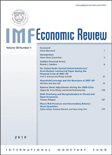
IMF Economic Review
Elevating Academic Dialogue in Economics and FinanceIMF Economic Review, published by Palgrave Macmillan Ltd, stands as a preeminent journal in the fields of Economics and Business Management, holding a prestigious Q1 ranking in both categories as of 2023. With an ISSN of 2041-4161 and an E-ISSN of 2041-417X, this journal not only showcases high-quality, peer-reviewed research but also embraces the principles of Open Access, promoting wide dissemination of its findings to researchers, professionals, and students alike. Spanning significant years from 2010 to 2024, the IMF Economic Review features innovative analyses and insights that challenge conventional economic paradigms and foster deeper understanding of global economic dynamics. Its impressive Scopus ranking places it in the top 10% of economics journals globally, affirming its vital role in advancing academic discourse and practical application in economics and finance. For those dedicated to exploring the intricacies of economic theory and practice, the IMF Economic Review is an invaluable resource that not only informs but also inspires.
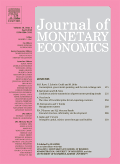
JOURNAL OF MONETARY ECONOMICS
Unraveling Complexities in Monetary EconomicsJOURNAL OF MONETARY ECONOMICS, published by Elsevier, stands as a premier platform for scholars and practitioners in the field of monetary economics. With a robust ISSN of 0304-3932 and E-ISSN 1873-1295, this esteemed journal has maintained a significant influence since its inception in 1975, continuing its legacy of rigorous scholarship through to 2024. The journal is recognized for its high impact in the field, boasting a Q1 category in both Economics and Econometrics and Finance as per the 2023 rankings. Its Scopus rankings underscore its prominence, with a top percentile standing in critical categories—a testament to its critical role in advancing research and discourse. While not an open-access publication, it offers invaluable insights for those dedicated to understanding complex fiscal dynamics and economic policies. The Journal of Monetary Economics serves as an essential resource for researchers, professionals, and students eager to explore the intricacies of financial systems and economic theory.
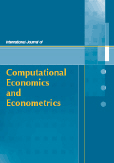
International Journal of Computational Economics and Econometrics
Fostering interdisciplinary collaboration for real-world economic impact.International Journal of Computational Economics and Econometrics is a peer-reviewed academic journal published by INDERSCIENCE ENTERPRISES LTD, focusing on the intersection of computational methodologies and economic analysis. With an ISSN of 1757-1170 and an E-ISSN of 1757-1189, this journal provides a crucial platform for researchers and professionals interested in innovative computational approaches to tackle real-world economic problems. While it currently does not operate under an open-access model, the journal is committed to advancing knowledge in its field, particularly as it occupies a vital niche within Computer Science Applications and Economics and Econometrics, ranking in the Q4 quartile for both categories as of 2023. Covering the period from 2017 to 2024, the journal aims to foster interdisciplinary collaboration and encourage the integration of advanced computational techniques into traditional economic theory and practice. As it continues to evolve, the International Journal of Computational Economics and Econometrics remains essential for academics and practitioners looking to stay at the forefront of technological innovations in economics.

International Advances in Economic Research
Fostering Academic Excellence in Economic ResearchInternational Advances in Economic Research, published by SPRINGER, stands as a significant resource within the field of economics and econometrics, consistently contributing to the theoretical and empirical understanding of economic phenomena since its inception in 1995. With an ISSN of 1083-0898 and E-ISSN of 1573-966X, this journal is dedicated to advancing economic research through a rigorous peer-review process and disseminating high-quality scholarly articles. The journal's esteemed classification places it in the third quartile (Q3) within the Economics and Econometrics category for 2023, indicating its respectable standing in academic circles. It serves as an important conduit for the dissemination of innovative economic theories, data analysis, and policy discussions, appealing to researchers, professionals, and students alike. Though not an open-access journal, it provides valuable subscription-based content that enriches the understanding of diverse economic issues and fosters a community of inquiry among academics. With its projected outlook extending to 2024, International Advances in Economic Research continues to be an essential platform for scholars aiming to influence and engage with contemporary economic debates.

American Economic Journal-Macroeconomics
Delivering High-Impact Research in MacroeconomicsAmerican Economic Journal-Macroeconomics, published by the American Economic Association, stands at the forefront of economic research, addressing pivotal macroeconomic issues that shape global economies. With an impressive Scopus rank of #8 out of 288 in its field and a notable 97th percentile ranking, this journal is widely regarded as a top-tier publication, specifically categorized in the Q1 category for Economics, Econometrics, and Finance as of 2023. Operating under ISSN 1945-7707 and E-ISSN 1945-7715, it aims to disseminate high-quality research from 2009 through 2024 and beyond, providing crucial insights into macroeconomic theory and policy. Although the journal currently does not operate under an open access model, it remains a vital resource for researchers, economists, and students seeking to deepen their understanding of macroeconomic dynamics and their implications for economic policy worldwide. The journal's impactful contributions make it an essential read for those striving to influence economic thought and practice.

Quantitative Finance and Economics
Transforming Financial Decision-Making Through Rigorous StudiesQuantitative Finance and Economics, published by the American Institute of Mathematical Sciences (AIMS), is a pioneering open-access journal committed to advancing the fields of finance and economics. Established to disseminate high-quality research, this journal has been an open-access platform since 2017, promoting wider accessibility to vital academic findings. It serves as a crucial resource for researchers and professionals alike, offering valuable insights through rigorous studies in quantitative methods that influence financial and economic decision-making. Although current Scopus rankings indicate emerging challenges, with a rank in the lower percentiles across various categories, Quantitative Finance and Economics strives to gain recognition by bridging theoretical frameworks with practical applications. The journal invites contributions that explore innovative quantitative techniques and their implications in contemporary economic scenarios, thus underscoring its role in shaping discourse and research in this critical sector.
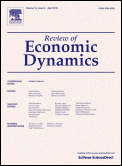
REVIEW OF ECONOMIC DYNAMICS
Transforming Economic Analysis for a Changing WorldREVIEW OF ECONOMIC DYNAMICS, published by Academic Press Inc, Elsevier Science, is a leading academic journal in the field of economics and econometrics, holding a distinguished Q1 ranking in its category as of 2023. With an impactful focus on the theoretical and empirical analysis of dynamic economic systems, the journal seeks to advance our understanding of economic dynamics through innovative research that addresses contemporary issues and policy implications. The journal boasts a significant history of contributions from renowned scholars since its inception in 1998, and will continue to publish through 2025. Although it does not currently offer open access options, the journal serves as a crucial resource for researchers, professionals, and students who are keen to explore and engage with the latest findings in economic theory and practice. With a current Scopus rank of #280 out of 716 in the Economics and Econometrics category, the REVIEW OF ECONOMIC DYNAMICS remains an invaluable platform for scholarly discussion and insight into the complexities of economic behavior.